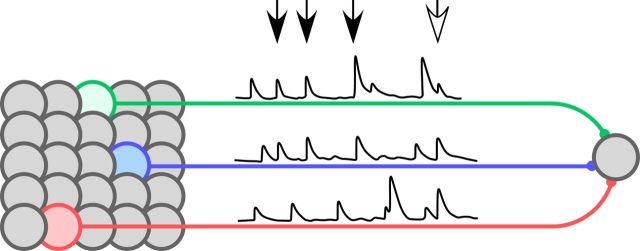Figure 9.
STP diversity can enrich information transmission in the TC pathway. The schematic shows different TC neurons within a VPM population (at left). These can encode distinct stimulus features and therefore respond at different times (reflected in the trains of PSPs corresponding to synaptic inputs from the three colored neurons). The green and blue neurons encode similar stimulus features and tend to respond in greater synchrony, while the red neuron tends to respond at different times. All three connect to a cortical neuron, at right. At certain moments, TC connections from both the green and blue neurons are strong enough to permit the downstream cell to selectively detect synchrony across those neurons (black arrows). Information about the value of the stimulus features encoded by the green and blue neurons is specifically transmitted at those times. However, at other moments differences in STP across the connections (the connection from the green neuron depresses more than the blue), combined with slight differences in spike timing, can lead to a switch in the subset of neurons whose partial synchrony can be detected: now, the subset includes either the green or the blue neuron together with others. For example, the white arrow indicates a time when the green, blue, and red neurons fire together but only the blue and red connections are strong enough to affect the activation of the downstream cell. At this time, it is the value of the features encoded by the blue and red neurons that is transmitted.

